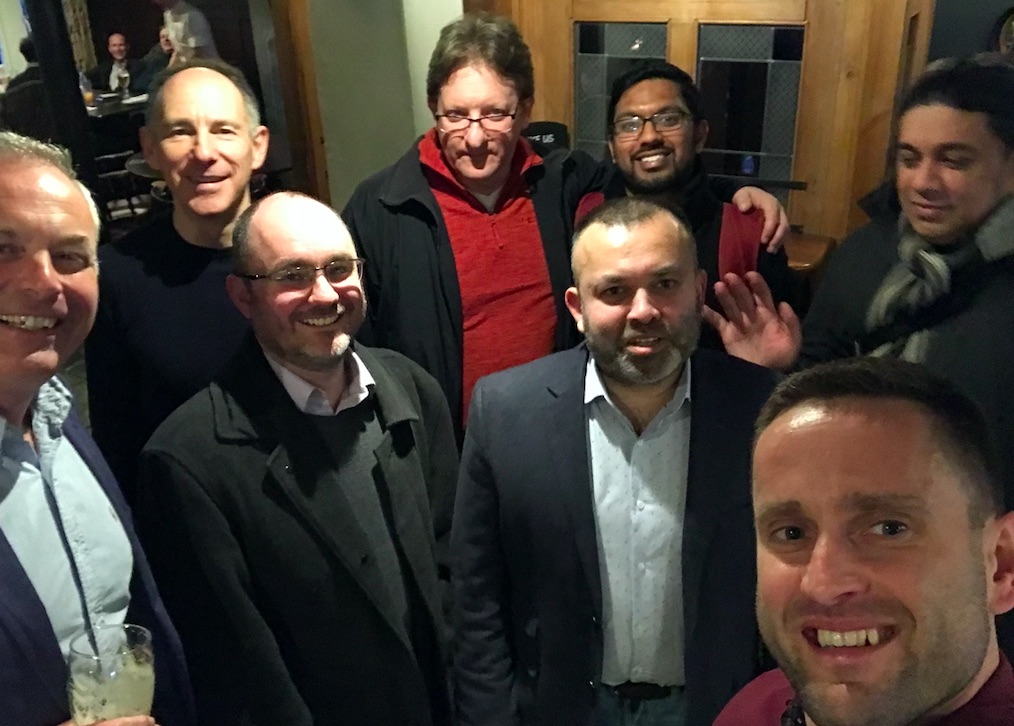SaaS Pricing Workshop – Peers helping each other
Manoj
Today, we held our 9th Workshop, this time on Pricing at Techcelerate Member Company, My Digital Accounts in Cheadle Hulme, Cheshire. Both pre-revenue startups, as well as those generating well over £50k Monthly Recurring Revenue (MRR), took part. Among the participants were:
Revenue generating:
- Malinko CEO, Andrew Threlfall
- My Digital Accounts, CTO, John Morris and Head of Sales, Joshua Bramhall. Later joined by CEO, John Whelan.
- Wadaro CEO, Robert Wakeling
- VoiceIQ CTO, Amila Palahepitiya
Very early stage;
Facilitated by:
- Sales Velocity (Techcelerate Partner for B2B Sales), Ian Walton
- Techcelerate Founder (aka me), Manoj Ranaweera
It was a pleasure to watch how companies shared highly confidential information with peers, for the benefit of all involved within a safe and trusted setting. Companies were happy to share pricing problems without fear of pre-judgement. There were no false pretences. Whilst my role was more of a facilitator, Ian shared his own experiences as well as how to fix some of the problems discussed. Everyone else chipped in to help each other.
All of the 4 revenue-generating companies had at least one person responsible for Sales in addition to the CEO. Whereas the two smaller companies, the CEOs were responsible for customer development and eventual sales.

There were many issues discussed, of some of the key ones highlighted below:
- Sales would close a deal, only for the delivery team to renegotiate, as the product requires further development to satisfy the sale. This results in development that does not align with the overall product map, causing immense headaches to the Product Owner. Whilst the MRR goes up, the product gets bloated which does not help in the long run.
- In a situation such as above, would it make sense to remove the pressure on MRR growth and get the product fixed first before going after sales which would have required product development previously? Of course, this means there would be a dip in sales, but the time taken to fix the product could eventually not just recover the potential dip, but allow you to accelerate sales at a faster growth rate, eventually resulting in a bigger win for the company.
- Simplified pricing to reduce sales friction, but resulting in leaving cash on the table. Tiered pricing which is still competitive is a better approach in these situations.
- Pricing additional product development cost based on cost-plus strategy. Whilst some adopted this resulting in bloated products, others adopted a very high man-day rate to remove the customisations or additional development requested by customers which are misaligned with the product road map. A customer would most likely accept a man-day rate of £250 vs £1600. So select the pricing to either win additional professional services or simply to force the customer to reject customisations or additional product development due to very higher costs. The choice really depends on the maturity of the company as well as the investment cycle. There are so many factors that could influence the desired outcome.
- Having to adopt competitive pricing instead of a value-based pricing strategy, due to of course the competitive landscape. This has resulted in premium products having to compete at the same pricing as substandard products. If the customers aren’t willing to pay for the premium prices, then it’s better to ditch them and find those who value the best. Especially the early adopters of technology.
- Where products result in digital transformation, it’s difficult to avoid not providing professional services. By providing professional services, it skews the ability to scale the business, as more customers mean more staff to service them. However, getting rid of this element means that the customer would not have sufficient handholding during the change forced by adopting the product, resulting in incorrect usage or lack of usage, eventually creating more churn. Overcoming such a scenario is not always easy.
As you can see from the above examples, pricing is not something that could be fixed in a Workshop. But I hope, everyone left with enough ideas to experiment and explore improving their pricing strategies and methodologies. Based on the feedback below, they seem to have enjoyed the workshop.
Ram Raghavan, CEO of Aira said,
“The pricing workshop helped me gain a holistic view of the challenges at every stage of growth. It was stimulating and being challenged in a friendly environment helped me personally to see how I could revise the offering to enhance the value for my target group.”
John Morris, CTO of My Digital Accounts said,
“A fascinating thought provoking meeting of minds on all things pricing.”
Bharat Lad, CEO of DadShed said,
“A genuinely valuable workshop, to understand how other SaaS businesses price and in particular learn about the issues that arise from bespoke customer requests beyond the internal product roadmap. What we came away with regards to the DadShed offer is we may need to focus on the compliance benefits of our technology and less on the commercial benefits, as a way to gain some sales/traction.”
Ian Walton, Founder of Sales Velocity said,
“Excellent pricing workshop organised by Manoj and Techcelerate. It’s great to share challenges and ideas with peers in a trusted environment.”
“There was certainly lively debate in a safe space to discuss what are challenging issues.”
As pricing strategies go:
- Value-based or outcome-based pricing is typically considered as the best way to price a software product, where the product has a competitive advantage, especially for a targeted market segment.
- Premium pricing can also play a part in the above situations, but this generally works with early adopters. Apple has demonstrated this over and over with its physical products such as MacBooks, iphones, etc.
- Cost-plus is not a great pricing strategy nor is competitive pricing. But these may be the only options, especially within a commodity market such as Customer Relationship Management (CRM). However, even within CRM, you can price based on outcome as some of the new entrants have done, demanding higher prices on niche or limited functionality offering.
If anyone would like to further read up on pricing, Lincoln Murphy of Sixteen Ventures is your man. During the first Techcelerate from 2006 to 2013, I ran a pricing workshop with Lincoln, which Andrew from Malinko took part in. It happened in fact almost 10 years ago on 27th April 2010. Telepresence facility was then provided by late Terry Bland, who founded Godel Technologies in Manchester.
I for one enjoyed facilitating the workshop. As Techcelerate tradition goes, we continued the conversation in the local pub.
